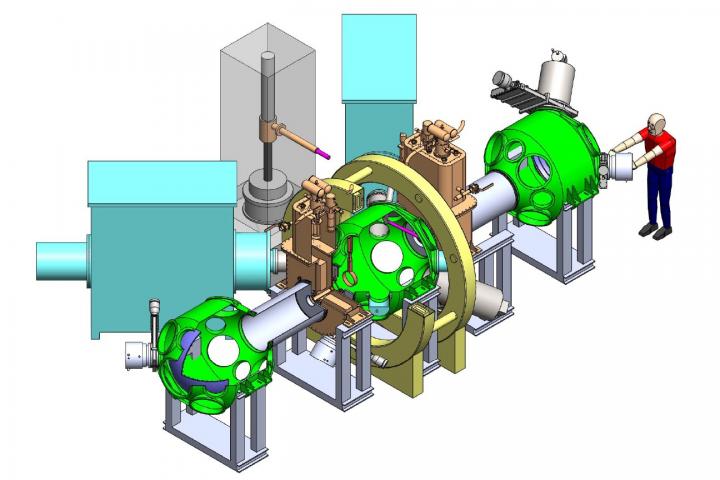New research helps explain why the solar wind is hotter than expected

A mirror machine is a linear fusion reactor. It allows scientists to apply research in themachines to an understanding of solar wind phenomena. Courtesy of Cary Forest / UW-Madison
In a study published April 14 in the Proceedings of the National Academy of Sciences, University of Wisconsin-Madison physicists provide an explanation for the discrepancy in solar wind temperature.
Their findings suggest ways to study solar wind phenomena in research labs and learn about solar wind properties in other star systems.
“People have been studying the solar wind since its discovery in 1959, but there are many important properties of this plasma which are still not well understood,” says Stas Boldyrev, professor of physics and lead author of the study.
“Initially, researchers thought the solar wind has to cool down very rapidly as it expands from the sun, but satellite measurements show that as it reaches the Earth, its temperature is 10 times larger than expected. So, a fundamental question is: Why doesn't it cool down?”
Solar plasma is a molten mix of negatively charged electrons and positively charged ions. Because of this charge, solar plasma is influenced by magnetic fields that extend into space, generated underneath the solar surface.
As the hot plasma escapes from the sun's outermost atmosphere, its corona, it flows through space as solar wind. The electrons in the plasma are much lighter particles than the ions, so they move about 40 times faster.
With more negatively charged electrons streaming away, the sun takes on a positive charge. This makes it harder for the electrons to escape the sun's pull. Some electrons have a lot of energy and keep traveling for infinite distances.
Those with less energy can't escape the sun's positive charge and are attracted back to the sun. As they do, some of those electrons can be knocked off their tracks ever-so-slightly by collisions with surrounding plasma.
“There is a fundamental dynamical phenomenon that says that particles whose velocity is not well aligned with the magnetic field lines are not able to move into a region of a strong magnetic field,” Boldyrev says.
“Such returning electrons are reflected so that they stream away from the sun, but again they cannot escape because of the attractive electric force of the sun. So, their destiny is to bounce back and forth, creating a large population of so-called trapped electrons.”
In an effort to explain the temperature observations in the solar wind, Boldyrev and his colleagues, UW-Madison physics professors Cary Forest and Jan Egedal looked to a related, but distinct, field of plasma physics for a possible explanation.
Around the time scientists discovered solar wind, plasma fusion researchers were thinking of ways to confine plasma. They developed “mirror machines,” or plasma-filled magnetic field lines shaped as tubes with pinched ends, like bottles with open necks on either end.
As charged particles in the plasma travel along the field lines, they reach the bottleneck and the magnetic field lines are pinched. The pinch acts as a mirror, reflecting particles back into the machine.
“But some particles can escape, and when they do, they stream along expanding magnetic field lines outside the bottle. Because the physicists want to keep this plasma very hot, they want to figure out how the temperature of the electrons that escape the bottle declines outside this opening,” Boldyrev says. “It's very similar to what's happening in the solar wind that expands away from the sun.”
Boldyrev and colleagues thought they could apply the same theory from the mirror machines to the solar wind, looking at the differences in the trapped particles and those that escape. In mirror machine studies, the physicists found that the very hot electrons escaping the bottle were able to distribute their heat energy slowly to the trapped electrons.
“In the solar wind, the hot electrons stream from the sun to very large distances, losing their energy very slowly and distributing it to the trapped population,” Boldyrev says. “It turns out that our results agree very well with measurements of the temperature profile of the solar wind and they may explain why the electron temperature declines with the distance so slowly,” Boldyrev says.
The accuracy with which mirror machine theory predicts solar wind temperature opens the door for using them to study solar wind in laboratory settings.
“Maybe we'll even find some interesting phenomena in those experiments that space scientists will then try to look for in the solar wind,” Boldyrev says. “It's always fun when you start doing something new. You don't know what surprises you'll get.”
###
Sarah Perdue, saperdue@wisc.edu, 608-262-3051
CONTACT: Stas Boldyrev, boldyrev@wisc.edu
READ ONLINE: https:/
DOWNLOAD IMAGES: https:/
Media Contact
All latest news from the category: Physics and Astronomy
This area deals with the fundamental laws and building blocks of nature and how they interact, the properties and the behavior of matter, and research into space and time and their structures.
innovations-report provides in-depth reports and articles on subjects such as astrophysics, laser technologies, nuclear, quantum, particle and solid-state physics, nanotechnologies, planetary research and findings (Mars, Venus) and developments related to the Hubble Telescope.
Newest articles

New theory reveals the shape of a single photon
A new theory, that explains how light and matter interact at the quantum level has enabled researchers to define for the first time the precise shape of a single photon….

Perovskite research boosts solar cell efficiency and product life
An international team led by the University of Surrey with Imperial College London have identified a strategy to improve both the performance and stability for solar cells made out of…

Neuroscientists discover how the brain slows anxious breathing
Salk scientists identify brain circuit used to consciously slow breathing and confirm this reduces anxiety and negative emotions. Deep breath in, slow breath out… Isn’t it odd that we can…



